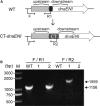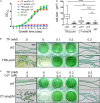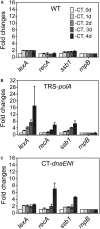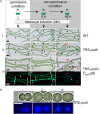Functional Dissection of Genes Encoding DNA Polymerases Based on Conditional Mutants in the Heterocyst-Forming Cyanobacterium Anabaena PCC 7120
- PMID: 32582078
- PMCID: PMC7283527
- DOI: 10.3389/fmicb.2020.01108
Functional Dissection of Genes Encoding DNA Polymerases Based on Conditional Mutants in the Heterocyst-Forming Cyanobacterium Anabaena PCC 7120
Abstract
The filamentous cyanobacterium Anabaena sp. PCC 7120 develops N2-fixing heterocyst cells under condition of combined-nitrogen deprivation and constitutes an excellent model for studying cell differentiation. The mechanism of heterocyst development has been extensively investigated and a network of regulating factors has been identified. A few studies have showed that the process of heterocyst differentiation relates with cell cycle events, but further investigation is still required to understand this relationship. In a previous study, we created a conditional mutant of PolI encoding gene, polA, by using a CRISPR/Cpf1 gene-editing technique. Here, we were able to create another conditional mutant of a PolIII encoding gene dnaENI using a similar strategy and subsequently confirmed the essential roles of both polA and dnaENI in DNA replication. Further investigation on the phenotype of the mutants showed that lack of PolI caused defects in chromosome segregation and cell division, while lack of DnaENI (PolIII) prevented bulk DNA synthesis, causing significant loss of DNA content. Our findings also suggested the possible existence of a SOS-response like mechanism operating in Anabaena PCC 7120. Moreover, we found that heterocyst development was differently affected in the two conditional mutants, with double heterocysts/proheterocysts found in PolI conditional mutant. We further showed that formation of such double heterocysts/proheterocysts are likely caused by the difficulty in nucleoids segregation, resulting delayed, or non-complete closure of the septum between the two daughter cells. This study uncovers a link between DNA replication process and heterocyst differentiation, paving the way for further studies on the relationship between cell cycle and cell development.
Keywords: DNA replication; SOS response; cell cycle; cyanobacteria; heterocyst.
Copyright © 2020 Xing, Xie, Zeng, Yang and Zhang.
Figures





Similar articles
-
cyAbrB Transcriptional Regulators as Safety Devices To Inhibit Heterocyst Differentiation in Anabaena sp. Strain PCC 7120.J Bacteriol. 2019 Aug 8;201(17):e00244-19. doi: 10.1128/JB.00244-19. Print 2019 Sep 1. J Bacteriol. 2019. PMID: 31085690 Free PMC article.
-
Identification of the oriC region and its influence on heterocyst development in the filamentous cyanobacterium Anabaena sp. strain PCC 7120.Microbiology (Reading). 2011 Jul;157(Pt 7):1910-1919. doi: 10.1099/mic.0.047241-0. Epub 2011 Apr 14. Microbiology (Reading). 2011. PMID: 21493684
-
Relationship among several key cell cycle events in the developmental cyanobacterium Anabaena sp. strain PCC 7120.J Bacteriol. 2006 Aug;188(16):5958-65. doi: 10.1128/JB.00524-06. J Bacteriol. 2006. PMID: 16885464 Free PMC article.
-
Heterocyst differentiation and pattern formation in cyanobacteria: a chorus of signals.Mol Microbiol. 2006 Jan;59(2):367-75. doi: 10.1111/j.1365-2958.2005.04979.x. Mol Microbiol. 2006. PMID: 16390435 Review.
-
The cell wall in heterocyst formation by Anabaena sp. PCC 7120.J Basic Microbiol. 2009 Feb;49(1):5-24. doi: 10.1002/jobm.200800300. J Basic Microbiol. 2009. PMID: 19253332 Review.
Cited by
-
c-di-GMP Homeostasis Is Critical for Heterocyst Development in Anabaena sp. PCC 7120.Front Microbiol. 2021 Dec 3;12:793336. doi: 10.3389/fmicb.2021.793336. eCollection 2021. Front Microbiol. 2021. PMID: 34925302 Free PMC article.
-
A c-di-GMP binding effector controls cell size in a cyanobacterium.Proc Natl Acad Sci U S A. 2023 Mar 28;120(13):e2221874120. doi: 10.1073/pnas.2221874120. Epub 2023 Mar 22. Proc Natl Acad Sci U S A. 2023. PMID: 36947515 Free PMC article.
-
Global translational control by the transcriptional repressor TrcR in the filamentous cyanobacterium Anabaena sp. PCC 7120.Commun Biol. 2023 Jun 15;6(1):643. doi: 10.1038/s42003-023-05012-9. Commun Biol. 2023. PMID: 37322092 Free PMC article.
-
HetF Protein Is a New Divisome Component in a Filamentous and Developmental Cyanobacterium.mBio. 2021 Aug 31;12(4):e0138221. doi: 10.1128/mBio.01382-21. Epub 2021 Jul 13. mBio. 2021. PMID: 34253066 Free PMC article.
-
Control of Cell Size by c-di-GMP Requires a Two-Component Signaling System in the Cyanobacterium Anabaena sp. Strain PCC 7120.Microbiol Spectr. 2023 Feb 14;11(1):e0422822. doi: 10.1128/spectrum.04228-22. Epub 2023 Jan 10. Microbiol Spectr. 2023. PMID: 36625639 Free PMC article.
References
-
- Borthakur P. B., Orozco C. C., Young-Robbins S. S., Haselkorn R., Callahan S. M. (2005). Inactivation of patS and hetN causes lethal levels of heterocyst differentiation in the filamentous cyanobacterium Anabaena sp. PCC 7120. Mol. Microbiol. 57 111–123. 10.1111/j.1365-2958.2005.04678.x - DOI - PubMed
LinkOut - more resources
Full Text Sources
Molecular Biology Databases

